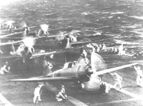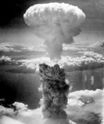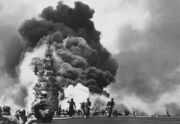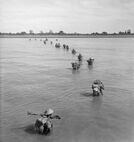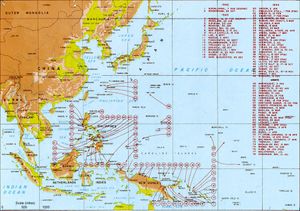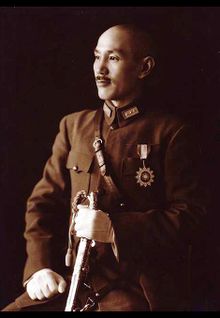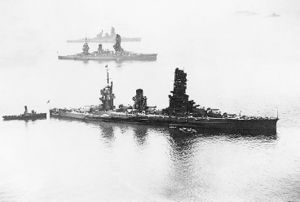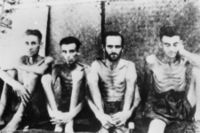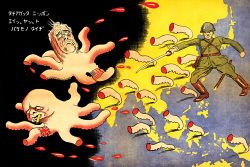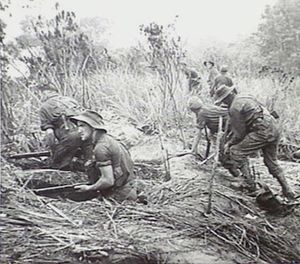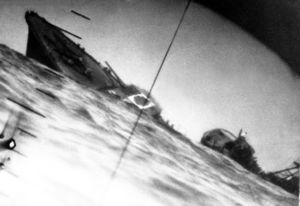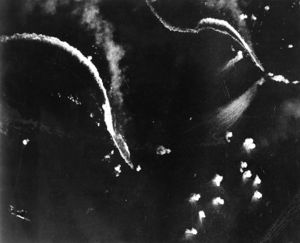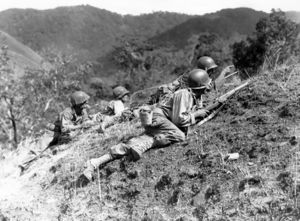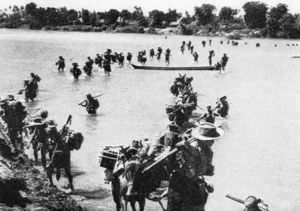حرب المحيط الهادي
حرب المحيط الهادي Pacific War، وتسمى أحيانا حرب المحيط آسيا-الهادي[29] هي جزء من الحرب العالمية الثانية وقعت في المحيط الهادي، والجزر التابعة له، وفي منطقة شرق آسيا، والتي يطلق عليها حاليا الشرق الأقصى. يستخدم مصطلح حرب المحيط الهدي ليضم مسرح عمليات المحيط الهادي ومسرح عمليات غرب المحيط الهادي وومسرح عمليات جنوب شرق آسيا والحرب الصينية اليابانية الثانية، ويشمل أيضا النزاع السوڤيتي الياباني 1945.
بدأت أحداث حرب المحيط الهدي في 7/8 ديسمبر 1941 مع الغزو الياباني لتايلاند[30] حتى الغزو البريطاني لمالايا، والهجوم على پيرل هاربر في أراضي هاواي الأمريكية من قبل اليابان.[31][32][33][34] ويعتبر بعض المؤرخون أن الصراح في آسيا قد بدأ في 7 يوليو 1937، مع نشوب الحرب الصينية اليابانية الثانية بين إمبراطورية اليابان وجمهورية الصين، أو ربما 19 سبتمبر 1931، بداية من الغزو الياباني لمنشوريا.[35] ومع ذلك، فالأكثر قبولاً هو اعتبار تاريخ بداية الحرب في أوائل ديسمبر 1941، مع نشوب الحرب الصينية اليابانية التي أصبحت جزء من حرب المحيط الهادي، باعتباره مسرحاً للعمليات للعسكرية في المحيط الهادي في الحرب العالمية الثانية.[36][37]
The Pacific War saw the Allies pitted against Japan, the latter aided by Thailand and to a lesser extent by the Axis powers, Germany and Italy. The Japanese achieved great success in the initial phase of the campaign, but were gradually driven back using an island hopping strategy. The Allies adopted a Europe first stance, giving first priority to defeating Nazi Germany, but still managed to bring to bear the vast industrial might of the United States. The Japanese had great difficulty replacing their losses in ships and aircraft, while American factories and shipyards produced ever increasing numbers of both. Fighting included some of the largest naval battles in history and massive Allied air raids over Japan, as well as the atomic bombings of Hiroshima and Nagasaki.
Japan surrendered unconditionally on 15 August 1945 and was occupied by the Allies. Japan lost its former possessions in Asia and the Pacific and had its sovereignty limited to the four main home islands and other minor islands as determined by the Allies.[38]
استعراض
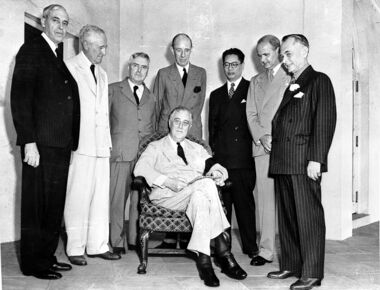 The Pacific War Council as photographed on 12 October 1942. Pictured are representatives من الولايات المتحدة (جالساً)، وأستراليا وكندا ونيوزيلندا، والمملكة المتحدة والصين، وهولندا وكومنولث الفلبين |
أسماء الحرب
In Allied countries during the war, the "Pacific War" was not usually distinguished from World War II, or was known simply as the War against Japan. In the United States, the term Pacific Theater was widely used. The US Armed Forces considered the China-Burma-India Theater to be distinct from the Asiatic-Pacific Theater during the conflict.
Japan used the name Greater East Asia War (大東亜戦争, Dai Tō-A Sensō), as chosen by a cabinet decision on 10 December 1941, to refer to both the war with the Western Allies and the ongoing war in China. This name was released to the public on 12 December, with an explanation that it involved Asian nations achieving their independence from the Western powers through armed forces of the Greater East Asia Co-Prosperity Sphere.[39] Japanese officials integrated what they called the Japan–China Incident (日支事変, Nisshi Jihen) into the Greater East Asia War. During the Occupation of Japan (1945–52), these terms were prohibited in official documents (although their informal usage continued). The war became officially known as the Pacific War (太平洋戦争, Taiheiyō Sensō). The Fifteen Years' War (十五年戦争, Jūgonen Sensō) is also used, referring to the period from the Mukden Incident of 1931 through 1945.
المشاركون
الحلفاء
The major Allied participants were China, the United States and the British Empire. China had already been engaged in a bloody war against Japan since 1937. The US and its territories, including the Philippine Commonwealth, entered the war after being attacked by Japan. The British Empire was also a major belligerent consisting of British troops along with large numbers of colonial troops from the armed forces of India as well as from Burma, Malaya, Fiji, Tonga; in addition to troops from Australia, New Zealand and Canada. The Dutch government-in-exile (as the possessor of the Dutch East Indies) was also involved. All of these were members of the Pacific War Council.[40] From 1944 the French commando group Corps Léger d'Intervention also took part in resistance operations in Indochina. Some active pro-allied guerrillas in Asia included the Malayan Peoples' Anti-Japanese Army, the Korean Liberation Army, the Free Thai Movement, the Việt Minh,[41] and the Hukbalahap.[42][بحاجة لمصدر]
The Soviet Union fought two short, undeclared border conflicts with Japan in 1938 and again in 1939, then remained neutral through the Soviet–Japanese Neutrality Pact of April 1941,[43] until August 1945 when it (and Mongolia) joined the rest of the Allies and invaded the territory of Manchukuo, China, Inner Mongolia, the Japanese protectorate of Korea and Japanese-claimed territory such as South Sakhalin.[44]
Mexico provided air support in the form of the 201st Fighter Squadron and Free France sent naval support in the form of Le Triomphant and later the Richelieu.
Axis powers and aligned states
The Axis-aligned states which assisted Japan included the authoritarian government of Thailand. Also involved were members of the Greater East Asia Co-Prosperity Sphere, which included the Manchukuo Imperial Army and Collaborationist Chinese Army of the Japanese puppet states of Manchukuo (consisting of most of Manchuria), and the collaborationist Wang Jingwei regime (which controlled the coastal regions of China), respectively. In the Burma campaign, the anti-British Indian National Army and the Burma National Army fought alongside their Japanese allies.[بحاجة لمصدر]
Japan conscripted many soldiers from its colonies of Korea and Taiwan. Collaborationist security units were also formed in Hong Kong, Singapore, the Philippines, the Dutch East Indies, British Malaya, British Borneo, former French Indochina (after the overthrow of the French regime in 1945), as well as Timorese militia.
Germany and Italy both had limited involvement in the Pacific War. The German and the Italian navies operated submarines and raiding ships in the Indian and Pacific Oceans, notably the Monsun Gruppe.
مسارح العمليات
Between 1942 and 1945, there were four main areas of conflict in the Pacific War: China, the Central Pacific, South-East Asia and the South West Pacific. US sources refer to two theaters within the Pacific War: the Pacific theater and the China Burma India Theater (CBI). However, these were not operational commands.
In the Pacific, the Allies divided operational control of their forces between two supreme commands, known as Pacific Ocean Areas and Southwest Pacific Area.[45]
The Imperial Japanese Navy (IJN) did not integrate its units into permanent theater commands. The Imperial Japanese Army (IJA), which had already created the Kwantung Army to oversee its occupation of Manchukuo and the China Expeditionary Army during the Second Sino-Japanese War, created the Southern Expeditionary Army Group at the outset of its conquests of South East Asia. This headquarters controlled the bulk of the Japanese Army formations which opposed the Western Allies in the Pacific and South East Asia.
خلفية تاريخية
الصراع بين الصين واليابان
In 1931, without declaring war, Japan invaded Manchuria, seeking raw materials to fuel its growing industrial economy. By 1937, Japan controlled Manchuria and it was ready to move deeper into China. The Marco Polo Bridge Incident on 7 July 1937 provoked full-scale war between China and Japan. The Nationalist Party and the Chinese Communists suspended their civil war in order to form a nominal alliance against Japan, and the Soviet Union quickly lent support by providing large amounts of materiel to Chinese troops. In August 1937, Generalissimo Chiang Kai-shek deployed his best army to fight about 300,000 Japanese troops in Shanghai, but, after three months of fighting, Shanghai fell.[46][صفحة مطلوبة] The Japanese continued to push the Chinese forces back, capturing the capital Nanjing in December 1937 and conducted the Nanjing Massacre.[47][صفحة مطلوبة] In March 1938, Nationalist forces won their first victory at Taierzhuang,[48][صفحة مطلوبة] but then the city of Xuzhou was taken by the Japanese in May. In June 1938, Japan deployed about 350,000 troops to invade Wuhan and captured it in October.[49][صفحة مطلوبة] The Japanese achieved major military victories, but world opinion—in particular in the US—condemned Japan, especially after the Panay incident.
In 1939, Japanese forces tried to push into the Soviet Far East. They were soundly defeated in the Battle of Khalkhin Gol by a mixed Soviet and Mongolian force led by Georgy Zhukov. This stopped Japanese expansion to the north, and Soviet aid to China ended as a result of the signing of the Soviet–Japanese Neutrality Pact.[50][صفحة مطلوبة] In September 1940, Japan decided to invade French Indochina, which was controlled at the time by Vichy France. On 27 September Japan signed a military alliance with Germany and Italy, becoming one of the three main Axis Powers.
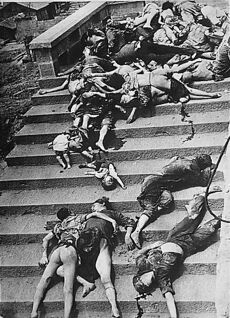
The war entered a new phase with the unprecedented defeat of the Japanese at the Battle of Suixian–Zaoyang, 1st Battle of Changsha, Battle of Kunlun Pass and Battle of Zaoyi. After these victories, Chinese nationalist forces launched a large-scale counter-offensive in early 1940; however, due to its low military-industrial capacity, it was repulsed in late March 1940.[51] In August 1940, Chinese communists launched an offensive in Central China; in retaliation, Japan instituted the "Three Alls Policy" ("Kill all, Burn all, Loot all") in occupied areas.[52]
By 1941 the conflict had become a stalemate. Although Japan had occupied much of northern, central, and coastal China, the Nationalist Government had retreated to the interior with a provisional capital set up at Chongqing while the Chinese communists remained in control of base areas in Shaanxi. The Japanese found its aggression against the retreating and regrouping Chinese army was stalled by the mountainous terrain in southwestern China while the Communists organised widespread guerrilla and saboteur activities in northern and eastern China behind the Japanese front line.[بحاجة لمصدر]
Japan sponsored several puppet governments, one of which was headed by Wang Jingwei.[53] However, its policies of brutality toward the Chinese population, of not yielding any real power to these regimes, and of supporting several rival governments failed to make any of them a viable alternative to the Nationalist government led by Chiang Kai-shek. Conflicts between Chinese Communist and Nationalist forces vying for territory control behind enemy lines culminated in a major armed clash in January 1941, effectively ending their co-operation.[54]
Japanese strategic bombing efforts mostly targeted large Chinese cities such as Shanghai, Wuhan, and Chongqing, with around 5,000 raids from February 1938 to August 1943 in the later case. Japan's strategic bombing campaigns devastated Chinese cities extensively, killing 260,000–350,934 non-combatants.[55][56][صفحة مطلوبة]
التوترات بين اليابان والقوى الغربية
As early as 1935, Japanese military strategists had concluded the Dutch East Indies were, because of their oil reserves, important to Japan. By 1940 they had expanded this to include Indochina, Malaya, and the Philippines within their concept of the Greater East Asia Co-Prosperity Sphere. Japanese troop build-ups in Hainan, Taiwan, and Haiphong were noted, IJA officers were openly talking about war, and Admiral Sankichi Takahashi was reported as saying a showdown with the US was necessary.[57]
In an effort to discourage Japanese militarism, Western powers including Australia, the US, Britain, and the Dutch government in exile, which controlled the Dutch East Indies, stopped selling oil, iron ore, and steel to Japan. In Japan, the government and nationalists viewed these embargoes as acts of aggression; imported oil made up about 80% of domestic consumption, without which Japan's economy would grind to a halt. The Japanese media, influenced by military propagandists,[ث] began to refer to the embargoes as the "ABCD line" ("American-British-Chinese-Dutch").
التحضيرات اليابانية
تطلبت خطة الشرق:
- هجمات أولية على الأسطول الأمريكي في المحيط الهادي في پيرل هاربر، هاواي، وحاملة طائراتمعتمدة على الأسطول المشترك.
- تلى تلك الهجمات:
تطلبت الخطة الجنوبية:
- الهجوم على المالايا وهونگ كونگ
- تلى ذلك الهجوم على:
- عزل أستراليا ونيوزيلندا
التدخل الألماني والإيطالي
الهجمات الياباني على القوى الغربية
الهجوم على پيرل هاربر
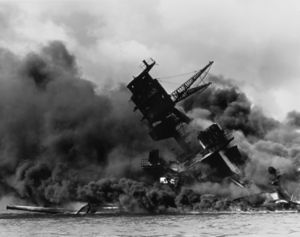
الهجمات اليابانية، 1941–42
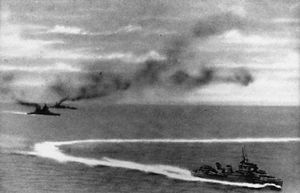
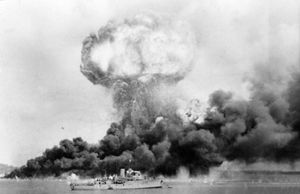
مسرح عمليات أستراليا
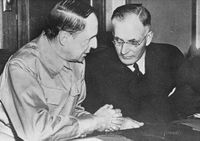
اعادة تجميع الحلفاء
بحر الكورال وميدوي: نقطة التحول
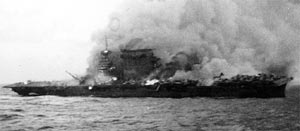
غينيا الجديدة وجزر سليمان
گوادال كانال
تقدم الحلفاء في غينيا الجديدة وجزر سليمان
المأزق في الصين وجنوب شرق آسيا
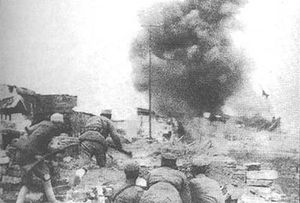
هجمات الحلفاء، 1943–44
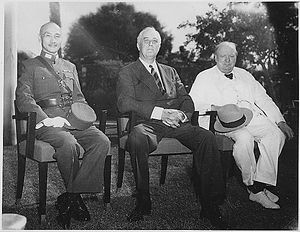
حرب الغواصات

الهجوم الياباني المضاد في الصين 1944
الهجوم الياباني على الهند 1944

بداية النهاية في المحيط الهادي 1944
سايپان وبحر الفلپين
خليج ليته 1944
الفلپين 1944–45
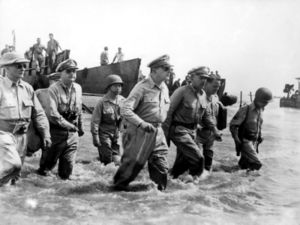
المراحل النهائية
إيوا جيما، فبراير 1945
هجمات الحلفاء على بورما 1944–45
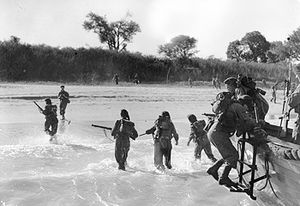
تحرير بورنيو
اوكيناوا
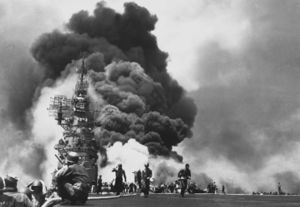
الإبرار في الجزر اليابانية
الغزو السوڤيتي والقنبلة الذرية

الاستسلام
The effects of the "Twin Shocks"—the Soviet entry and the atomic bombing—were profound. On 10 August the "sacred decision" was made by Japanese Cabinet to accept the Potsdam terms on one condition: the "prerogative of His Majesty as a Sovereign Ruler". At noon on 15 August, after the American government's intentionally ambiguous reply, stating that the "authority" of the emperor "shall be subject to" the Supreme Commander of the Allied Powers", the Emperor broadcast to the nation and to the world at large the rescript of surrender,[60] ending the Second World War.
"Should We continue to fight, it would not only result in an ultimate collapse and obliteration of the Japanese nation, but also it would lead to the total extinction of human civilization." -Emperor Hirohito.[61]
In Japan, 14 August is considered to be the day that the Pacific War ended. However, as Imperial Japan actually surrendered on 15 August, this day became known in the English-speaking countries as "V-J Day" (Victory in Japan).[62] The formal Japanese Instrument of Surrender was signed on 2 September 1945, on the battleship يوإسإس Missouri, in Tokyo Bay. The surrender was accepted by General Douglas MacArthur as Supreme Commander for the Allied Powers, with representatives of several Allied nations, from a Japanese delegation led by Mamoru Shigemitsu and Yoshijiro Umezu.
بعد تلك الفترة، ذهب مكارثر إلى طوكيو ليشرف على تنمية البلد بعد الحرب. هذه الفترة في التاريخ الياباني تُعرف بإسم الاحتلال.
جرائم الحرب
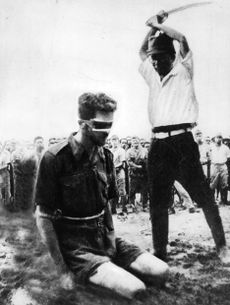
حملات المحيط الهادي
الحرب الصينية اليابانية
قبل عام 1941 وإدراجها ضمن حرب المحيط الهادي:
 1937-07-07 – 1937-07-09 حادث جسر ماركو پولو
1937-07-07 – 1937-07-09 حادث جسر ماركو پولو 1937-08-13 – 1937-11-26 معركة شنغهاي
1937-08-13 – 1937-11-26 معركة شنغهاي 1937-09-01 – 1937-11-09 معركة تاييوان
1937-09-01 – 1937-11-09 معركة تاييوان 1937-12-09 – 1938-01-31 معاركة نانينگ
1937-12-09 – 1938-01-31 معاركة نانينگ 1938-03-24 – 1938-05-01 Battle of Xuzhou
1938-03-24 – 1938-05-01 Battle of Xuzhou 1938-06-11 – 1938-10-27 Battle of Wuhan
1938-06-11 – 1938-10-27 Battle of Wuhan 1939-03-17 – 1939-05-09 معركة نانچانگ
1939-03-17 – 1939-05-09 معركة نانچانگ 1939-04-20 - 1939-05-24 Battle of Suixian-Zaoyang
1939-04-20 - 1939-05-24 Battle of Suixian-Zaoyang 1939-09-13 - 1939-10-08 Battle of Changsha (1939)
1939-09-13 - 1939-10-08 Battle of Changsha (1939) 1939-11-15 - 1940-11-30 Battle of South Guangxi
1939-11-15 - 1940-11-30 Battle of South Guangxi 1940-05-01 - 1940-06-18 Battle of Zaoyang-Yichang
1940-05-01 - 1940-06-18 Battle of Zaoyang-Yichang 1941-01-30 - 1941-03-01 Battle of South Henan
1941-01-30 - 1941-03-01 Battle of South Henan 1941-03-14 - 1941-04-09 Battle of Shanggao
1941-03-14 - 1941-04-09 Battle of Shanggao 1941-05-07 – 1941-05-27 Battle of South Shanxi
1941-05-07 – 1941-05-27 Battle of South Shanxi 1941-09-06 - 1941-10-08 Battle of Changsha (1941)
1941-09-06 - 1941-10-08 Battle of Changsha (1941)
بعد إدراجهم في حرب المحيط الهادي:
 1941-02-24 - 1942-01-15 Battle of Changsha (1942)
1941-02-24 - 1942-01-15 Battle of Changsha (1942) 1942-05-14 - 1942-09-07 Zhejiang-Jiangxi Campaign
1942-05-14 - 1942-09-07 Zhejiang-Jiangxi Campaign 1943-05-12 - 1943-06-03 Battle of West Hubei
1943-05-12 - 1943-06-03 Battle of West Hubei 1943-11-02 - 1943-12-20 Battle of Changde
1943-11-02 - 1943-12-20 Battle of Changde 1944-04-17 - 1944-12-10 Operation Ichi-Go
1944-04-17 - 1944-12-10 Operation Ichi-Go
 1945-04-09 - 1945-06-07 Battle of West Hunan
1945-04-09 - 1945-06-07 Battle of West Hunan
- 1940-09-22 – 1940-09-25 معركة لانگ سن
- 1940-09-24 – 1940-09-26 قصف هاي فونگ
- October 1940 – 9 May 1941
![]() نزاعات الحدود السوڤيتية اليابانية
نزاعات الحدود السوڤيتية اليابانية
- 1938-07-29 – 1938-08-11 Battle of Lake Khasan
- 1939-05-11 – 1939-09-16 Battles of Khalkhin Gol
الاحتلال الياباني لجنوب شرق آسيا والهادي
 1941-12-07 (12-08 Asian Time) Attack on Pearl Harbor
1941-12-07 (12-08 Asian Time) Attack on Pearl Harbor 1941-12-08 Japanese invasion of Thailand
1941-12-08 Japanese invasion of Thailand 1941-12-08 Battle of Guam (1941)
1941-12-08 Battle of Guam (1941)- 1941-12-07 Japan declares war on the United States and the United Kingdom; 1941-12-08 The United States and the United Kingdom declare war on Japan
 1941-12-08 – 1941-12-25 Battle of Hong Kong
1941-12-08 – 1941-12-25 Battle of Hong Kong 1941-12-08 – 1942-01-31 Malayan Campaign
1941-12-08 – 1942-01-31 Malayan Campaign 1941-12-10 Sinking of إتشإمإس Prince of Wales and إتشإمإس Repulse
1941-12-10 Sinking of إتشإمإس Prince of Wales and إتشإمإس Repulse 1941-12-11 – 1941-12-24 Battle of Wake Island
1941-12-11 – 1941-12-24 Battle of Wake Island 1941-12-16 – 1942-04-01 Battle of Borneo (1941–42)
1941-12-16 – 1942-04-01 Battle of Borneo (1941–42) 1941-12-22 – 1942-05-06 Battle of the Philippines
1941-12-22 – 1942-05-06 Battle of the Philippines- 1942-01-01 – 1945-10-25 Transport of POWs via hell ships
 1942-01-11 – 1942-01-12 Battle of Tarakan[63]
1942-01-11 – 1942-01-12 Battle of Tarakan[63] 1942-01-23 Battle of Rabaul (1942)
1942-01-23 Battle of Rabaul (1942) 1942-01-24 Battle of Balikpapan (1942)[64]
1942-01-24 Battle of Balikpapan (1942)[64]- 1942-01-25 تايلند declares war on the Allies
 1942-01-30 – 1942-02-03 Battle of Ambon[65]
1942-01-30 – 1942-02-03 Battle of Ambon[65] 1942-01-30 – 1942-02-15 Battle of Singapore
1942-01-30 – 1942-02-15 Battle of Singapore 1942-02-04 Battle of Makassar Strait
1942-02-04 Battle of Makassar Strait 1942-02-14 – 1942-02-15 Battle of Palembang[66]
1942-02-14 – 1942-02-15 Battle of Palembang[66] 1942-02-19 Air raids on Darwin, Australia
1942-02-19 Air raids on Darwin, Australia 1942-02-19 – 1942-02-20 Battle of Badung Strait[67]
1942-02-19 – 1942-02-20 Battle of Badung Strait[67] 1942-02-19 – 1943-02-10 Battle of Timor (1942-43)[68][69]
1942-02-19 – 1943-02-10 Battle of Timor (1942-43)[68][69] 1942-02-27 – 1942-03-01 Battle of the Java Sea[70]
1942-02-27 – 1942-03-01 Battle of the Java Sea[70] 1942-03-01 Battle of Sunda Strait[71]
1942-03-01 Battle of Sunda Strait[71] 1942-03-01 – 1942-03-09 Battle of Java[72]
1942-03-01 – 1942-03-09 Battle of Java[72] 1942-03-31 Battle of Christmas Island[73]
1942-03-31 Battle of Christmas Island[73] 1942-03-31 – 1942-04-10 Indian Ocean raid
1942-03-31 – 1942-04-10 Indian Ocean raid- 1942-04-09 Bataan Death March begins
 1942-04-18 Doolittle Raid
1942-04-18 Doolittle Raid 1942-05-03 Japanese invasion of Tulagi
1942-05-03 Japanese invasion of Tulagi
 1942-05-04 – 1942-05-08 Battle of the Coral Sea
1942-05-04 – 1942-05-08 Battle of the Coral Sea 1942-05-31 – 1942-06-08 Attacks on Sydney Harbour area, Australia
1942-05-31 – 1942-06-08 Attacks on Sydney Harbour area, Australia 1942-06-04 – 1942-06-06 Battle of Midway
1942-06-04 – 1942-06-06 Battle of Midway
هجمات الحلفاء
| See Atlas of Battle Fronts from July 1943 to August 1945 at Half-Month intervals | ||
|---|---|---|
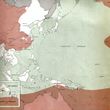 1943-07-01 |
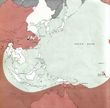 1943-12-01 |
 1944-05-01 |
 1944-11-01 |
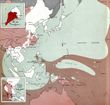 1945-03-01 |
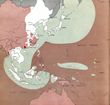 1945-08-01 |
South East Asian campaigns: 1941-12-08 – 1945-08-15



 Burma Campaign: 1941-12-16 – 1945-08-15
Burma Campaign: 1941-12-16 – 1945-08-15 1945-05-15 – 1945-05-16 Battle of the Malacca Strait
1945-05-15 – 1945-05-16 Battle of the Malacca Strait
 1942-01-23 – Battle of Rabaul
1942-01-23 – Battle of Rabaul- 1942-03-07 – Operation Mo (Japanese invasion of mainland New Guinea)

 1942-05-04 – 1942-05-08 Battle of the Coral Sea
1942-05-04 – 1942-05-08 Battle of the Coral Sea 1942-07-01 – 1943-01-31 Kokoda Track Campaign
1942-07-01 – 1943-01-31 Kokoda Track Campaign
 1942-08-25 – 1942-09-05 Battle of Milne Bay
1942-08-25 – 1942-09-05 Battle of Milne Bay
 1942-11-19 – 1943-01-23 Battle of Buna-Gona
1942-11-19 – 1943-01-23 Battle of Buna-Gona
 1943-01-28 – 1943-01-30 Battle of Wau
1943-01-28 – 1943-01-30 Battle of Wau
 1943-03-02 – 1943-03-04 Battle of the Bismarck Sea
1943-03-02 – 1943-03-04 Battle of the Bismarck Sea
 1943-06-29 – 1943-09-16 Battle of Lae
1943-06-29 – 1943-09-16 Battle of Lae

 1943-06-30 – 1944-03-25 Operation Cartwheel
1943-06-30 – 1944-03-25 Operation Cartwheel
 1943-09-19 – 1944-04-24 Finisterre Range campaign
1943-09-19 – 1944-04-24 Finisterre Range campaign
 1943-09-22 – 1944-01-15 Huon Peninsula campaign
1943-09-22 – 1944-01-15 Huon Peninsula campaign

 1943-11-01 – 1943-11-11 Attack on Rabaul
1943-11-01 – 1943-11-11 Attack on Rabaul

 1943-12-15 – 1945-08-15 New Britain campaign
1943-12-15 – 1945-08-15 New Britain campaign 1944-02-29 – 1944-03-25 Admiralty Islands campaign
1944-02-29 – 1944-03-25 Admiralty Islands campaign
 1944-04-22 – 1945-08-15 Western New Guinea campaign
1944-04-22 – 1945-08-15 Western New Guinea campaign



 1942-05-05 – 1942-11-06 Battle of Madagascar
1942-05-05 – 1942-11-06 Battle of Madagascar

 1942-06-06 – 1943-08-15 Battle of the Aleutian Islands
1942-06-06 – 1943-08-15 Battle of the Aleutian Islands
 1942-06-07 – 1943-08-15 Battle of Kiska
1942-06-07 – 1943-08-15 Battle of Kiska 1943-03-26 – Battle of the Komandorski Islands
1943-03-26 – Battle of the Komandorski Islands



 1942-08-07 – 1943-02-09 Battle of Guadalcanal
1942-08-07 – 1943-02-09 Battle of Guadalcanal 1942-08-09 Battle of Savo Island
1942-08-09 Battle of Savo Island
 1942-08-24 – 1942-08-25 Battle of the Eastern Solomons
1942-08-24 – 1942-08-25 Battle of the Eastern Solomons 1942-10-11 – 1942-10-12 Battle of Cape Esperance
1942-10-11 – 1942-10-12 Battle of Cape Esperance- 1942-10-25 – 1942-10-27 Battle of the Santa Cruz Islands

 1942-11-13 – 1942-11-15 Naval Battle of Guadalcanal
1942-11-13 – 1942-11-15 Naval Battle of Guadalcanal 1942-11-30 Battle of Tassafaronga
1942-11-30 Battle of Tassafaronga
 1943-01-29 – 1943-01-30 Battle of Rennell Island
1943-01-29 – 1943-01-30 Battle of Rennell Island 1943-03-06 Battle of Blackett Strait
1943-03-06 Battle of Blackett Strait


 1943-06-10 – 1943-08-25 New Georgia Campaign
1943-06-10 – 1943-08-25 New Georgia Campaign- 1943-07-06 Battle of Kula Gulf
 1943-07-12 – 1943-07-13 Battle of Kolombangara
1943-07-12 – 1943-07-13 Battle of Kolombangara 1943-08-06 – 1943-08-07 Battle of Vella Gulf
1943-08-06 – 1943-08-07 Battle of Vella Gulf 1943-08-17 – 1943-08-18 Battle off Horaniu
1943-08-17 – 1943-08-18 Battle off Horaniu

 1943-08-15 – 1943-10-09 Land Battle of Vella Lavella
1943-08-15 – 1943-10-09 Land Battle of Vella Lavella 1943-10-06 Naval Battle of Vella Lavella
1943-10-06 Naval Battle of Vella Lavella


 1943-11-01 – 1945-08-21 Battle of Bougainville
1943-11-01 – 1945-08-21 Battle of Bougainville 1943-11-01 – 1943-11-02 Battle of Empress Augusta Bay
1943-11-01 – 1943-11-02 Battle of Empress Augusta Bay 1943-11-26 Battle of Cape St. George
1943-11-26 Battle of Cape St. George
 1943-11-20 – 1943-11-23 Battle of Tarawa
1943-11-20 – 1943-11-23 Battle of Tarawa 1943-11-20 – 1943-11-24 Battle of Makin
1943-11-20 – 1943-11-24 Battle of Makin 1944-01-31 – 1944-02-07 Battle of Kwajalein
1944-01-31 – 1944-02-07 Battle of Kwajalein 1944-02-16 – 1944-02-17 Attack on Truk
1944-02-16 – 1944-02-17 Attack on Truk 1944-02-16 – 1944-02-23 Battle of Eniwetok
1944-02-16 – 1944-02-23 Battle of Eniwetok

 Operation Cockpit 1944-04-19
Operation Cockpit 1944-04-19
 Operation Transom 1944-05-17
Operation Transom 1944-05-17
 Bombing of Bangkok 1944-05-20
Bombing of Bangkok 1944-05-20 Operation Matterhorn 1944-06-05 – May 1945
Operation Matterhorn 1944-06-05 – May 1945 Operation Meridian 1945-01-24 – 1945-01-29
Operation Meridian 1945-01-24 – 1945-01-29
 1944-06-15 – 1944-07-09 Battle of Saipan
1944-06-15 – 1944-07-09 Battle of Saipan 1944-06-19 – 1944-06-20 Battle of the Philippine Sea
1944-06-19 – 1944-06-20 Battle of the Philippine Sea 1944-07-21 – 1944-08-10 Battle of Guam[74]
1944-07-21 – 1944-08-10 Battle of Guam[74] 1944-07-24 – 1944-08-01 Battle of Tinian[74]
1944-07-24 – 1944-08-01 Battle of Tinian[74] 1944-09-15 – 1944-11-25 Battle of Peleliu[75]
1944-09-15 – 1944-11-25 Battle of Peleliu[75] 1944-09-17 – 1944-09-30 Battle of Angaur[75]
1944-09-17 – 1944-09-30 Battle of Angaur[75]


 1944-10-20 – 1944-12-10 Battle of Leyte
1944-10-20 – 1944-12-10 Battle of Leyte
 1944-10-24 – 1944-10-25 Battle of Leyte Gulf
1944-10-24 – 1944-10-25 Battle of Leyte Gulf 1944-11-11 – 1944-12-21 Battle of Ormoc Bay
1944-11-11 – 1944-12-21 Battle of Ormoc Bay

 1944-12-15 – 1945-07-04 Battle of Luzon
1944-12-15 – 1945-07-04 Battle of Luzon
 1945-01-09 Invasion of Lingayen Gulf
1945-01-09 Invasion of Lingayen Gulf
 1945-01-31 – 1945-02-08 Recapture of Bataan
1945-01-31 – 1945-02-08 Recapture of Bataan
 1945-02-03 – 1945-03-03 Battle of Manila
1945-02-03 – 1945-03-03 Battle of Manila
 1945-03-18 – 1945-07-30 Battle of the Visayas
1945-03-18 – 1945-07-30 Battle of the Visayas
 1945-03-10 – 1945-08-15 Battle of Mindanao
1945-03-10 – 1945-08-15 Battle of Mindanao
Volcano and Ryukyu Islands campaign
 1945-02-16 – 1945-03-26 Battle of Iwo Jima
1945-02-16 – 1945-03-26 Battle of Iwo Jima



 1945-04-01 – 1945-06-21 Battle of Okinawa
1945-04-01 – 1945-06-21 Battle of Okinawa 1945-04-07 Operation Ten-Go
1945-04-07 Operation Ten-Go


 1945-05-01 – 1945-05-25 Battle of Tarakan
1945-05-01 – 1945-05-25 Battle of Tarakan 1945-06-10 – 1945-06-15 Battle of Brunei
1945-06-10 – 1945-06-15 Battle of Brunei 1945-06-10 – 1945-06-22 Battle of Labuan
1945-06-10 – 1945-06-22 Battle of Labuan 1945-06-17 – 1945-08-15 Battle of North Borneo
1945-06-17 – 1945-08-15 Battle of North Borneo
 1945-07-07 – 1945-07-21 Battle of Balikpapan
1945-07-07 – 1945-07-21 Battle of Balikpapan
 1945-07-22 معركة خليج طوكيو
1945-07-22 معركة خليج طوكيو 1945-08-06 – 1945-08-09 الهجوم النووي على هيروشيما وناجازاكي
1945-08-06 – 1945-08-09 الهجوم النووي على هيروشيما وناجازاكي
 1945-08-08 – 1945-09-02 الغزو السوڤيتي لمنشوريا
1945-08-08 – 1945-09-02 الغزو السوڤيتي لمنشوريا
مناطق القيادة
- القيادة الأمريكية:
- القيادة البريطانية والحلفاء:
- GHQ India, commanding the British Army in India
- الأسطول الشرقي
- American-British-Dutch-Australian Command
- قيادة جنوب شرق آسيا
- Far East Command (Soviet Union), the Soviet command during the war against Japan in 1945
- القيادة اليابانية:
- Japanese Combined Fleet, the Japanese command which oversaw naval operations
- Southern Expeditionary Army Group, the Japanese army command in the South West Pacific and South East Asia
انظر أيضاً
- مسرح عمليات اوروپا في الحرب العالمية الثانية
- Dissent in the Armed Forces of the Empire of Japan
- European theatre of World War II
- Hull note
- Japanese-American service in World War II
- Japanese holdouts
- Japanese in the Chinese resistance to the Empire of Japan
- Nanshin-ron
- Pacific Theater aircraft carrier operations during World War II
- Pacific War campaigns
- War Plan Orange
- Yasukuni Shrine
- خط زمني لمسرح عمليات المحيط الهادي في الحرب العالمية الثانية
هوامش
- ^ Although Japan had been invading and occupying China since 1937, war was not officially declared. Japan would later attack Pearl Harbor on 7 December 1941, which brought the contained war in China into the wider global conflict.[3]
- ^ Strength of the US Military in Asia and the Pacific as of war's end: Army: 1,770,036,[7] Navy (excluding Coast Guard and Marines): 1,366,716,[8] and Marine Corps: 484,631.[9] These figures do not include the Coast Guard or naval personnel in the China-Burma-India theater.[10]
- ^ These numbers do not include the Royal Netherlands Navy.
- ^ : "It was not an official term, but a term of incitement used by the Japanese media, under the guidance of the military, in order to stir up the Japanese people's sense of crisis..."[58][59]
- ^ القائمة الكاملة الدول المتحالفة في حرب المحيط الهادي (وتشمل مشاركون أقل): جمهورية الصين، الولايات المتحدة، المملكة المتحدة (تشمل جزر فيجي، هونگ كونگ، مستوطنات المضائق ووقوى استعمارية أخرى)، مستعمرات المضائق#تاريخ القوات المسلحة التونگية|تونگا (محيمة بريطانية)، أستراليا وتشمل أرض غينيا الجديدة), وكومنولث الفليپين (تحت حماية الولايات المتحدة)، الهند البريطانية، هولندا (تشمل القوات الاستعمارية من جزر الهند الشرقية الهولندية)،الاتحاد السوڤيتي، نيوزيلندا، كندا, المكسيك، ومنغوليا. قوات فرنسا ڤيشي التي قاومت في اليابان لفترة قصيرة في الحرب الهندية الصينية الأولى عام 1940 وحاربت أيضاً ضد تايلاند عام 1940. كمدعم لقوى المحور، سمح نظام ڤيشي لليابانيين باستخدام القوات في الهند الصينية الفرنسية بدءاً من عام 1941. القوات البحرية الفرنسية الحربة ساهمات من الحلفاء بالعديد من السفن الحربية، مثل تريومفانت أو ساڤورنيان-دى-برازا. بعد تحرير فرنسا، السفينة الحربية الفرنسية ريشليو أُرسلوا إلى الهادي. الحلفاء الرئيسيون ضد الامبراطورية اليابانية مذكورون في هذا المرجع.[1]
تنظيمات عصابية حاربت بجانب الحلفاء مثل الجيش الأحمر الصيني، هوكبالهپ، جيش الملايو الشعبي المناهض لليابانيين، جيوش المتطوعين المناهضة لليابانيين المنشورية، جيش التحرير الكوري، والڤيت منه - ^ Complete list of nations and groups which fought on the Axis side in the Pacific War (including lesser contributors): امبراطورية اليابان (ضمت Taiwan under Japanese rule وكوريا تحت الحكم الياباني، تايلند، the puppet government of Manchukuo (منشوريا), Mengjiang, Wang Jingwei regime, and other Chinese collaborationist governments and organizations, Ba Maw Regime، الحكومة المؤقتة للهند الحرة، جمهورية الفلپين الثانية العميلة، ودول أخرى في Greater East Asia Co-Prosperity Sphere).
- ^ 3.8 million Chinese military casualties 1937-45 (3.2 million Nationalist/-allied and 580,000 Communist),[19] 354,523 United States casualties (106,207 killed, 248,316 wounded and missing),[20] 52,000 British casualties including 12,000 deaths in captivity,[بحاجة لمصدر] 86,838 British Indian casualties (this casualty figure is for all theatres of World War Two that Indian troops fought in),[21][صفحة مطلوبة] 17,501 Australian casualties,[22][صفحة مطلوبة] 57,000 casualties from the Philippine Commonwealth,[بحاجة لمصدر] around 9,400 Dutch casualties including 8,500 who died in captivity (likely not including colonial forces),[بحاجة لمصدر] 578 New Zealander casualties,[23] 63,225 Soviet casualties (20,797 killed and missing, 42,428 wounded and sick), 5000 French military casualties in Indochina, 300 Mongolian casualties[24] and 5 Mexican deaths [25] Malaria was the most important health hazard encountered by U.S. troops in the South Pacific during World War II, where about 500,000 men were infected.[26]
- ^ Over 17 million Chinese civilian deaths 1937-45,[19] around 4 million civilian deaths from the Dutch East Indies,[21][صفحة مطلوبة], two million Indochinese civilians,[27] around 1.5 million British Indian civilian deaths, 1/2 to one million Filipino civilian and hundreds of thousands of Burmese, Malayan, Pacific etc. civilian deaths.[21][صفحة مطلوبة]
- ^ 2,133,915 Japanese military deaths 1937-45,[28] 1.18 million Chinese collaborator casualties 1937-45 (432.000 dead),[بحاجة لمصدر] 22,000 Burmese casualties,[بحاجة لمصدر] 5,600 Thai casualties,[بحاجة لمصدر] and 2,615 Indian casualties.[بحاجة لمصدر]
- ^ 580,000 Japanese civilian deaths,[21][صفحة مطلوبة], 378,000 Korean and 300 Thai civilian deaths.[بحاجة لمصدر]
المراجع
- ^ The Avlon Project: A Decade of American Foreign Policy 1941-1949 Interim Meeting of Foreign Ministers, Moscow. Retrieved on 30 September 2009.
- ^ A Decade of American Foreign Policy 1941-1949 Interim Meeting of Foreign Ministers, Moscow. Retrieved 30 September 2009.
- ^ Ch'i 1992, p. 157.
- ^ Sun 1996, p. 11.
- ^ L, Klemen (1999–2000). "Lieutenant-General Hein Ter Poorten". Forgotten Campaign: The Dutch East Indies Campaign 1941-1942.
{{cite web}}: CS1 maint: date format (link) - ^ Hastings p. 205
- ^ Coakley and Leighton (1989). Global Logistics and Strategy 1943–1945 p. 836
- ^ US Navy Personnel in World War II Service and Casualty Statistics, Naval History and Heritage Command Table 9.
- ^ King, Ernest J. (1945). Third Report to the Secretary of the Navy p. 221
- ^ US Navy Personnel in World War II Service and Casualty Statistics, Naval History and Heritage Command Footnote 2.
- ^ أ ب Hastings, p. 10.
- ^ Beevor: The Second World War p. 776. Total involved in Manchuria
- ^ "Chapter 10: Loss of the Netherlands East Indies". The Army Air Forces in World War II: Vol. 1 – Plans & Early Operations. HyperWar. Retrieved 31 August 2010.
- ^ Cook (1992). Japan at War: an Oral History. New Press. ISBN 978-1-56584-039-3. p. 403. Japanese strength is given at 4,335,500 in the Home Islands and 3,527,000 abroad.
- ^ Harrison p. 29 Retrieved 10 March 2016
- ^ Australia-Japan Research Project, "Dispositions and Deaths" Retrieved 10 March 2016
- ^ Meyer, Milton Walter (1997). Asia: A Concise History. Lanham: Rowman & Littlefield. p. 309. ISBN 9780847680634.
- ^ Jowett, pp. 72
- ^ أ ب "Chinese People Contribute to WWII". Retrieved 2009-04-23.
- ^ The National World War II Museum, New Orleans[dead link]
- ^ أ ب ت ث Dower, John W (1987), War Without Mercy: Race and Power in the Pacific War. Pantheon
- ^ Dear, I.C.B and Foot, M.R.D. (editors) (2005). "Australia". The Oxford Companion to World War II. Oxford: Oxford University Press. p. 66. ISBN 9780192806703.
{{cite book}}:|last=has generic name (help)CS1 maint: multiple names: authors list (link) - ^ "Honouring NZ's Pacific War dead". Beehive. 2005-08-15. Retrieved 2010-10-31.
- ^ "Russia and USSR in Wars of XX century". И.И.Ивлев. Archived from the original on 2008-05-05. Retrieved 2008-07-11.
- ^ "Leyte Gulf: The Mexican Air Force".
- ^ "Science and the Pacific War: science and survival in the Pacific, 1939-1945". Roy M. MacLeod (2000). p.51. ISBN 0792358511
- ^ "Vietnam needs to remember famine of 1945". Mailman.anu.edu.au. Retrieved 2010-10-31.
- ^ Bren, John (2005-06-03) "Yasukuni Shrine: Ritual and Memory" Japan Focus. Retrieved on 2009-06-05.
- ^ Williamson Murray, Allan R. Millett A war to be won: fighting the Second World War, Harvard University Press, 2001, page 143
- ^ "Prime Minister Winston Churchill's Broadcast on War with Japan". British Library of Information. December 8, 1941. Retrieved March 6, 2011.
....we shall regard an attack on you as an attack upon ourselves
- ^ John Costello, The Pacific War: 1941-1945, Harper Perennial, 1982
- ^ B. H. Liddell Hart, History of the Second World War, Putnum, New York, 1971
- ^ Japan Economic Foundation, Journal of Japanese trade & industry, Volume 16, 1997
- ^ David Williams, Defending Japan's Pacific War: The Kyoto Philosophers and the Idea of a Post-White World, RoutledgeCurzon, 2004
- ^ Roy M. MacLeod, Science and the Pacific War: science and survival in the Pacific, 1939-1945, Kluwer Academic Publishing, p. 1, 1999
- ^ "For fifty-three long months, beginning in July 1937, China stood alone, single-handedly fighting an undeclared war against Japan. On 9 December 1941, after Japan's surprise attack on Pearl Harbor, China finally declared war against Japan. What had been for so long a war between two countries now became part of a much wider Pacific conflict." Hsi-sheng Ch'i, in James C. Hsiung and Steven I. Levine, China's bitter victory : the war with Japan 1937-1945, M.E. Sharpe, 1992, p. 157
- ^ Youli Sun, China and the Origins of the Pacific War, 1931-41, Palgrave MacMillan, p. 11
- ^ Takemae 2003, p. 516.
- ^ Jansen 2002, p. 626.
- ^ "WW2 People's War – Timeline". BBC. Archived from the original on 19 March 2011. Retrieved 31 October 2010.
- ^ "World War II and the founding of the Vietnamese state". Encyclopædia Britannica (Online ed.). Retrieved 25 August 2021.
- ^ "The Hukbalahap Insurrection: World War II and Huk Expansion". US Army. Retrieved 25 August 2021.
- ^ Sandler 2001, pp. 1067–1068.
- ^ Sandler 2001, p. 945.
- ^ "Map of the Pacific Theater". Archived from the original on 9 January 2009. Retrieved 31 October 2010.
- ^ Harmsen 2013.
- ^ Harmsen 2015.
- ^ Olsen 2012.
- ^ MacKinnon 2008.
- ^ Drea 2005.
- ^ Lin 2010, p. 55.
- ^ Garver 1988, p. 120.
- ^ Jansen 2002, p. 636.
- ^ Fairbank & Goldman 1994, p. 320.
- ^ Lind 2010.
- ^ Rummel 1991.
- ^ "Japans desperate gamble". Aberdeen Journal. 18 November 1940. Retrieved 6 May 2015 – via British Newspaper Archive.
- ^ Kokushi Daijiten ("Historical Dictionary"), 1980
- ^ Cited by Christopher Barnard, 2003, Language, Ideology and Japanese History Textbooks, London & New York, Routledge Curzon, p. 85.
- ^ Sadao Asada. The Shock of the Atomic Bomb and Japan's Decision to Surrender: A Reconsideration. The Pacific Historical Review, Vol. 67, No. 4 (Nov. 1998), pp. 477–512.
- ^ Patrick Clancey. "The Voice of the Crane: The Imperial Rescript of 15Aug45". ibiblio. University of North Carolina at Chapel Hill. Retrieved 27 September 2012.
- ^ "Chronology of Japanese Holdouts". Wanpela.com. Retrieved 31 October 2010.
- ^ L, Klemen (1999–2000). "The capture of Tarakan Island, January 1942". Forgotten Campaign: The Dutch East Indies Campaign 1941-1942.
{{cite web}}: CS1 maint: date format (link) - ^ L, Klemen (1999–2000). "The capture of Balikpapan, January 1942". Forgotten Campaign: The Dutch East Indies Campaign 1941-1942.
{{cite web}}: CS1 maint: date format (link) - ^ L, Klemen (1999–2000). "The Japanese Invasion of Ambon Island, January 1942". Forgotten Campaign: The Dutch East Indies Campaign 1941-1942.
{{cite web}}: CS1 maint: date format (link) - ^ L, Klemen (1999–2000). "The battle for Palembang, February 1942". Forgotten Campaign: The Dutch East Indies Campaign 1941-1942.
{{cite web}}: CS1 maint: date format (link) - ^ L, Klemen (1999–2000). "The Badung Strait Battle". Forgotten Campaign: The Dutch East Indies Campaign 1941-1942.
{{cite web}}: CS1 maint: date format (link) - ^ خطأ استشهاد: وسم
<ref>غير صحيح؛ لا نص تم توفيره للمراجع المسماةDutchTimor - ^ L, Klemen (1999–2000). "The fighting on Portuguese East Timor, 1942". Forgotten Campaign: The Dutch East Indies Campaign 1941-1942.
{{cite web}}: CS1 maint: date format (link) - ^ خطأ استشهاد: وسم
<ref>غير صحيح؛ لا نص تم توفيره للمراجع المسماةJavaSea - ^ Visser, Jan (1999–2000). "The Sunda Strait Battle". Forgotten Campaign: The Dutch East Indies Campaign 1941-1942.
{{cite web}}: CS1 maint: date format (link) - ^ خطأ استشهاد: وسم
<ref>غير صحيح؛ لا نص تم توفيره للمراجع المسماةJava - ^ L, Klemen (1999–2000). "The Mystery of Christmas Island, March 1942". Forgotten Campaign: The Dutch East Indies Campaign 1941-1942.
{{cite web}}: CS1 maint: date format (link) - ^ أ ب Potter & Nimitz, 1960, p.770
- ^ أ ب Ofstie(1946)p.275
المصادر
- Eric M. Bergerud, Fire in the Sky: The Air War in the South Pacific (2000)
- Clay Blair, Jr. Silent Victory. Philadelphia: Lippincott, 1975 (submarine war).
- Thomas Buell, Master of Seapower: A Biography of Admiral Ernest J. King Naval Institute Press, 1976.
- Thomas Buell, The Quiet Warrior: A Biography of Admiral Raymond Spruance. 1974.
- John Costello, The Pacific War. 1982.
- Wesley Craven, and James Cate, eds. The Army Air Forces in World War II. Vol. 1, Plans and Early Operations, January 1939 to August 1942. University of Chicago Press, 1958. Official history; Vol. 4, The Pacific: Guadalcanal to Saipan, August 1942 to July 1944. 1950; Vol. 5, The Pacific: Matterhorn to Nagasaki. 1953.
- Dunnigan, James F., and Albert A. Nofi. The Pacific War Encyclopedia. Facts on File, 1998. 2 vols. 772p.
- Harry A. Gailey.' 'The War in the Pacific: From Pearl Harbor to Tokyo Bay (1995)
- Gordon, David M. "The China-Japan War, 1931-1945" Journal of Military History (January 2006) v 70#1, pp 137–82. Historiographical overview of major books
- Seki, Eiji. (2006). Mrs. Ferguson's Tea-Set, Japan and the Second World War: The Global Consequences Following Germany's Sinking of the SS Automedon in 1940. London: Global Oriental. 10-ISBN 1-905246-28-5; 13- ISBN 978-1-905246-28-1 (cloth) (reprinted by University of Hawaii Press), Honolulu, 2007. previously announced as Sinking of the SS Automedon and the Role of the Japanese Navy: A New Interpretation.
- Saburo Hayashi and Alvin Coox. Kogun: The Japanese Army in the Pacific War. Quantico, Virginia: Marine Corps Assoc., 1959.
- William B. Hopkins. The Pacific War: The Strategy, Politics, and Players that Won the War (2010)
- James C. Hsiung and Steven I. Levine, eds. China's Bitter Victory: The War with Japan, 1937–1945 M. E. Sharpe, 1992
- Ch'i Hsi-sheng, Nationalist China at War: Military Defeats and Political Collapse, 1937–1945 University of Michigan Press, 1982
- Rikihei Inoguchi, Tadashi Nakajima, and Robert Pineau. The Divine Wind. Ballantine, 1958. Kamikaze.
- S. Woodburn Kirby, The War Against Japan. 4 vols. London: H.M.S.O., 1957-1965. Official Royal Navy history.
- L, Klemen (1999–2000). "Forgotten Campaign: The Dutch East Indies Campaign 1941-1942".
{{cite web}}: CS1 maint: date format (link) - William M. Leary, We Shall Return: MacArthur's Commanders and the Defeat of Japan. University Press of Kentucky, 1988.
- Gavin Long, Australia in the War of 1939–45, Army. Vol. 7, The Final Campaigns. Canberra: Australian War Memorial, 1963.
- Dudley McCarthy, Australia in the War of 1939–45, Army. Vol. 5, South-West Pacific Area—First Year: Kokoda to Wau. Canberra: Australian War Memorial, 1959.
- D. Clayton James, The Years of MacArthur. Vol. 2. Houghton Mifflin, 1972.
- Maurice Matloff and Edwin M. Snell Strategic Planning for Coalition Warfare 1941–1942, United States Army Center of Military History, Washington, D. C., 1990
- Miller, Edward S. (2007). War Plan Orange: The U.S. Strategy to Defeat Japan, 1897-1945. US Naval Institute Press. ISBN 1591145007.
{{cite book}}: Cite has empty unknown parameter:|coauthors=(help) - Samuel Eliot Morison, History of United States Naval Operations in World War II. Vol. 3, The Rising Sun in the Pacific. Boston: Little, Brown, 1961; Vol. 4, Coral Sea, Midway and Submarine Actions. 1949; Vol. 5, The Struggle for Guadalcanal. 1949; Vol. 6, Breaking the Bismarcks Barrier. 1950; Vol. 7, Aleutians, Gilberts, and Marshalls. 1951; Vol. 8, New Guinea and the Marianas. 1962; Vol. 12, Leyte. 1958; vol. 13, The Liberation of the Philippines: Luzon, Mindanao, the Visayas. 1959; Vol. 14, Victory in the Pacific. 1961.
- Masatake Okumiya, and Mitso Fuchida. Midway: The Battle That Doomed Japan. Naval Institute Press, 1955.
- E. B. Potter, and Chester W. Nimitz. Triumph in the Pacific. Prentice Hall, 1963. Naval battles
- E. B. Potter, Bull Halsey Naval Institute Press, 1985.
- E. B. Potter, Nimitz. Annapolis, Maryland: Naval Institute Press, 1976.
- John D. Potter, Yamamoto 1967.
- Gordon W. Prange, Donald Goldstein, and Katherine Dillon. At Dawn We Slept. Penguin, 1982. Pearl Harbor
- ——, et al. Miracle at Midway. Penguin, 1982.
- ——, et al. Pearl Harbor: The Verdict of History.
- Seki, Eiji (2007). Sinking of the SS Automedon And the Role of the Japanese Navy: A New Interpretation. University of Hawaii Press. ISBN 1905246285.
{{cite book}}: Cite has empty unknown parameter:|coauthors=(help) - Henry Shaw, and Douglas Kane. History of U.S. Marine Corps Operations in World War II. Vol. 2, Isolation of Rabaul. Washington, D.C.: Headquarters, U.S. Marine Corps, 1963
- Henry Shaw, Bernard Nalty, and Edwin Turnbladh. History of U.S. Marine Corps Operations in World War II. Vol. 3, Central Pacific Drive. Washington, D.C.: Office of the Chief of Military History, 1953.
- E.B. Sledge, With the Old Breed: At Peleliu and Okinawa. Presidio, 1981. Memoir.
- J. Douglas Smith, and Richard Jensen. World War II on the Web: A Guide to the Very Best Sites. (2002)
- Ronald Spector, Eagle Against the Sun: The American War with Japan Free Press, 1985.
- John Toland, The Rising Sun. 2 vols. Random House, 1970. Japan's war.
- Ian W. Toll. Pacific Crucible: War at Sea in the Pacific, 1941-1942 (2011)
- H. P. Willmott. Empires in the Balance. Annapolis: United States Naval Institute Press, 1982.
- H. P. Willmott. The Barrier and the Javelin. Annapolis: United States Naval Institute Press, 1983.
- Gerhard L. Weinberg, A World at Arms: A Global History of World War II, Cambridge University Press. ISBN 0-521-44317-2. (2005).
- William Y'Blood, Red Sun Setting: The Battle of the Philippine Sea. Annapolis, Maryland: Naval Institute Press, 1980.
- Harries, Meirion (1994). Soldiers of the Sun : The Rise and Fall of the Imperial Japanese Army. New York: Random House. ISBN 0-679-75303-6.
{{cite book}}: Unknown parameter|coauthors=ignored (|author=suggested) (help)
وصلات خارجية
- Film Footage of the Pacific War
- La politique de la sphère de coprospérité de la grande Asie orientale au Japon (بالفرنسية)
- Animated History of the Pacific War
- Canada in the Pacific War — Canadians in Asia & the Pacific
- The Pacific War Series – at The War Times Journal
- Morinoske: Japanese Pilot testimonials - and more
- Imperial Japanese Navy Page
- The Atomic Bomb and the End of World War II
قالب:States and territories in the sphere of influence of Imperial Japan during World War II
- تحويل قالب:امبراطورية اليابان
- Articles with unsourced statements from July 2009
- مقالات بالمعرفة بحاجة لذكر رقم الصفحة بالمصدر from September 2010
- CS1 maint: date format
- Articles with dead external links from October 2010
- CS1 errors: generic name
- Short description is different from Wikidata
- Missing redirects
- Articles with hatnote templates targeting a nonexistent page
- Pages using multiple image with auto scaled images
- Flagdeco with missing country data templates
- Articles with unsourced statements from April 2020
- Articles containing لاتينية-language text
- مقالات بالمعرفة بحاجة لذكر رقم الصفحة بالمصدر from October 2023
- Articles with unsourced statements from July 2023
- CS1 errors: unsupported parameter
- التاريخ العسكري لأوقيانوسيا
- مسرح عمليات المحيط الهادي في الحرب العالمية الثانية

